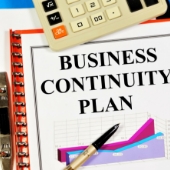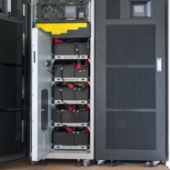 When it comes to business, one thing is certain: the unexpected will always find a way to disrupt your operations. Whether it’s a global pandemic, extreme weather conditions, or a cyberattack, it is essential to have measures in place that will allow your company to continue functioning during these uncertain times. A robust business continuity plan can make all the difference between your company surviving or failing.
When it comes to business, one thing is certain: the unexpected will always find a way to disrupt your operations. Whether it’s a global pandemic, extreme weather conditions, or a cyberattack, it is essential to have measures in place that will allow your company to continue functioning during these uncertain times. A robust business continuity plan can make all the difference between your company surviving or failing.
Back up your data
The most effective way to ensure business continuity is to back up your data regularly. Having a comprehensive data backup strategy is like having insurance for your most valuable digital assets. If any of your systems fail, become corrupted, or are inaccessible, these backups will allow you to quickly recover and minimize downtime.
When backing up your data, it’s important to consider off-site backups in addition to on-premises solutions. This will ensure that your data is safe in the event of a physical disaster, such as a fire or flood at your primary location. Additionally, cloud-based backup solutions can provide added security and accessibility for your data during times of crisis.
Virtualize your IT infrastructure
Virtualization is the process of creating a virtual version of a physical IT resource, such as a server or desktop. The virtualized resources are put into a virtual machine, which can be easily replicated and migrated to other physical machines as if it were a simple file. This allows for quick and efficient disaster recovery, as virtual machines can be easily backed up and restored to new hardware if necessary. Virtualization essentially provides flexibility and scalability, making it easier to recover your systems and maintain operations without extended downtime.
Install a UPS
Uninterruptible power supplies (UPS) are essential components of your business continuity strategy. They offer protection against power interruptions and surges, allowing your systems to continue running even during electrical outages. A UPS provides a buffer period for you to shut down your systems safely or transition to backup power sources, reducing the risk of data loss and downtime.
Consider a secondary recovery site or temporary hot desk arrangement
In scenarios where your primary business location becomes inaccessible due to natural disasters or other crises, having a secondary recovery site or temporary hot desk arrangement is a lifesaver. This tactic ensures that your employees can continue working, even when the primary workspace is unavailable. Establish agreements with co-working spaces or set up an alternative location where your team can temporarily relocate and access the necessary resources to keep your operations running smoothly.
Implement cloud solutions for remote work
The cloud has revolutionized the way businesses operate and has become a vital component of modern business continuity plans. Cloud solutions provide the flexibility to enable remote work, allowing your team to access essential applications and data from anywhere with an internet connection. This is particularly valuable during unforeseen disruptions, as your employees can work from home or any location, maintaining productivity and business operations.
If you want to ensure business continuity, we can help you develop and implement a comprehensive business continuity plan. Contact us today to learn more about our services.

 Businesses operate in a volatile world where unforeseen events such as cyberthreats and natural disasters can strike at any moment. To ensure your company’s survival, it’s essential to have the following business continuity strategies in place.
Businesses operate in a volatile world where unforeseen events such as cyberthreats and natural disasters can strike at any moment. To ensure your company’s survival, it’s essential to have the following business continuity strategies in place. Unforeseen events such as natural disasters, power outages, and cyberattacks can immensely disrupt business operations, resulting in significant financial loss and reputation damage. Therefore, having a solid business continuity plan in place is crucial for any organization’s survival. Here are five essential tactics that every company should implement to ensure business continuity.
Unforeseen events such as natural disasters, power outages, and cyberattacks can immensely disrupt business operations, resulting in significant financial loss and reputation damage. Therefore, having a solid business continuity plan in place is crucial for any organization’s survival. Here are five essential tactics that every company should implement to ensure business continuity. As a small- or medium-sized business (SMB) owner, you understand how challenging it can be to keep your company afloat. While you may have a solid business plan, unexpected events such as natural disasters or cybersecurity threats can disrupt your operations. This is where a business continuity plan (BCP) comes in. In this article, we’ll discuss why your SMB needs a BCP and how implementing one can help you stay resilient during times of crisis.
As a small- or medium-sized business (SMB) owner, you understand how challenging it can be to keep your company afloat. While you may have a solid business plan, unexpected events such as natural disasters or cybersecurity threats can disrupt your operations. This is where a business continuity plan (BCP) comes in. In this article, we’ll discuss why your SMB needs a BCP and how implementing one can help you stay resilient during times of crisis. No business owner wants to think about the possibility of a crisis that could halt operations, but the truth is that disasters can strike at any time. Whether it’s a pandemic, a cyberattack, or a natural disaster, unexpected events can significantly impact a company. That’s why it’s crucial to create a business continuity plan (BCP) that will enable your small- or medium-sized business (SMB) to survive and thrive during challenging times.
No business owner wants to think about the possibility of a crisis that could halt operations, but the truth is that disasters can strike at any time. Whether it’s a pandemic, a cyberattack, or a natural disaster, unexpected events can significantly impact a company. That’s why it’s crucial to create a business continuity plan (BCP) that will enable your small- or medium-sized business (SMB) to survive and thrive during challenging times. Small- and medium-sized businesses (SMBs) often operate with limited resources, making them particularly vulnerable to disruptions caused by unexpected events. While larger companies may have dedicated departments and resources to handle crises, SMBs often lack these luxuries. However, having a business continuity plan (BCP) can help mitigate these risks. In this article, we’ll explore why every SMB needs a BCP and how it can help your business bounce back from unexpected disruptions.
Small- and medium-sized businesses (SMBs) often operate with limited resources, making them particularly vulnerable to disruptions caused by unexpected events. While larger companies may have dedicated departments and resources to handle crises, SMBs often lack these luxuries. However, having a business continuity plan (BCP) can help mitigate these risks. In this article, we’ll explore why every SMB needs a BCP and how it can help your business bounce back from unexpected disruptions. Disasters can strike at any time, putting your valuable data at risk and dealing catastrophic damage to your bottom line. But by following a few simple steps in creating a disaster recovery plan (DRP), you can safeguard your business from data loss events and ensure that your information remains secure in the face of any potential disaster.
Disasters can strike at any time, putting your valuable data at risk and dealing catastrophic damage to your bottom line. But by following a few simple steps in creating a disaster recovery plan (DRP), you can safeguard your business from data loss events and ensure that your information remains secure in the face of any potential disaster. As a business owner, you know that data security is paramount. It’s therefore essential to ensure you have taken all necessary steps to protect yourself against potential data loss events, such as data breaches and natural disasters. In this essential guide, we will outline the key steps you should take in creating a disaster recovery plan (DRP). Following these can save your business from an incredibly costly catastrophe.
As a business owner, you know that data security is paramount. It’s therefore essential to ensure you have taken all necessary steps to protect yourself against potential data loss events, such as data breaches and natural disasters. In this essential guide, we will outline the key steps you should take in creating a disaster recovery plan (DRP). Following these can save your business from an incredibly costly catastrophe. No organization wants to experience the nightmare of losing valuable customer data, financial records, or confidential documents. Unfortunately, unless proper steps are taken to safeguard your business from these disasters, you may be unknowingly putting your data at risk of getting lost or compromised. Taking proactive measures and creating an effective disaster recovery plan (DRP) can make all the difference when it comes to defending your business from data disasters. Here’s how to create a DRP that works.
No organization wants to experience the nightmare of losing valuable customer data, financial records, or confidential documents. Unfortunately, unless proper steps are taken to safeguard your business from these disasters, you may be unknowingly putting your data at risk of getting lost or compromised. Taking proactive measures and creating an effective disaster recovery plan (DRP) can make all the difference when it comes to defending your business from data disasters. Here’s how to create a DRP that works. A power outage can be disastrous for a business. Not only does it interrupt work, but it can also lead to data loss and equipment damage. That’s why an uninterrupted power supply (UPS) is so important. In this blog, we will discuss the importance of UPS systems for businesses of all sizes.
A power outage can be disastrous for a business. Not only does it interrupt work, but it can also lead to data loss and equipment damage. That’s why an uninterrupted power supply (UPS) is so important. In this blog, we will discuss the importance of UPS systems for businesses of all sizes. Power outages are a huge inconvenience to businesses. They can lead to lost productivity and revenue, and they can cost you a lot in damages. That’s why it’s important for businesses like yours to invest in an uninterrupted power supply (UPS). Let’s take a closer look at some of the key reasons why every business should have a UPS system in place.
Power outages are a huge inconvenience to businesses. They can lead to lost productivity and revenue, and they can cost you a lot in damages. That’s why it’s important for businesses like yours to invest in an uninterrupted power supply (UPS). Let’s take a closer look at some of the key reasons why every business should have a UPS system in place. Are you tired of dealing with power outages? They can be a major inconvenience to businesses, leading to thousands of dollars in lost productivity and revenue. Fortunately, there’s something you can do about it: use an uninterrupted power supply (UPS) for your computers and networking equipment. Read on to learn more about the business benefits of using a UPS.
Are you tired of dealing with power outages? They can be a major inconvenience to businesses, leading to thousands of dollars in lost productivity and revenue. Fortunately, there’s something you can do about it: use an uninterrupted power supply (UPS) for your computers and networking equipment. Read on to learn more about the business benefits of using a UPS.